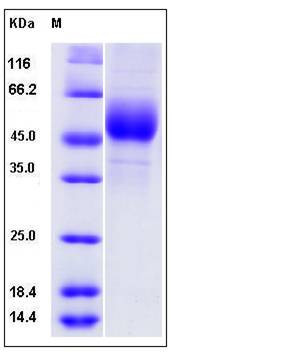Rat Ninjurin-1 / NINJ1 Protein (Fc Tag)
NINJ1
- 100ug (NPP3091) Please inquiry
| Catalog Number | P80424-R01H |
|---|---|
| Organism Species | Rat |
| Host | Human Cells |
| Synonyms | NINJ1 |
| Molecular Weight | The recombinant rat NINJ1/Fc chimera is a disulfide-linked homodimeric protein. The reduced monomer consists of 340 amino acids and has a calculated molecular mass of 37 kDa. In SDS-PAGE under reducing conditions, the apparent molecular mass of rat NINJ1/Fc monomer is approximately 50 kDa due to glycosylation. |
| predicted N | Glu |
| SDS-PAGE |  |
| Purity | > 95 % as determined by SDS-PAGE |
| Protein Construction | A DNA sequence encoding the rat NINJ1 (P70617) extracellular domain (Met 1-Pro 79) was fused with the Fc region of human IgG1 at the N-terminus. |
| Bio-activity | |
| Research Area | Neuroscience |Neurology process |Neuroregeneration |
| Formulation | Lyophilized from sterile PBS, pH 7.4 1. Normally 5 % - 8 % trehalose, mannitol and 0.01% Tween80 are added as protectants before lyophilization. Specific concentrations are included in the hardcopy of COA. |
| Background | Ninjurin-1, also known as NINJ1, is a member of the Ninjurin family of transmembrane (TM) proteins. It is expressed in CD19(+) CD10(+) B-cell progenitor cells and higher levels in B-lineage acute lymphoblastic leukemia cells. Ninjurin-1 is expressed also in a number of other adult and embryonic tissues, predominantly in epithelial cells. Its expression is upregulated after axotomy in neurons and in Schwann cells surrounding the distal nerve segment. Upregulated expression of ninjurin-1 has been identified as a marker of minimal residual disease in B-lineage acute lymphoblastic leukemia. It mediates homophilic adhesion, and promotes neurite extension of dorsal root ganglion neurons in vitro. Ninjurin-1 has been found to show a high expression level in the liver tissue of patients with hepatocellular carcinoma, and this seems to be associated with cases of cirrhosis and chronic viral hepatitis. It has been reported that NINJURIN increases p21 expression and induces cellular senescence in human hepatoma cells. |
| Reference |
